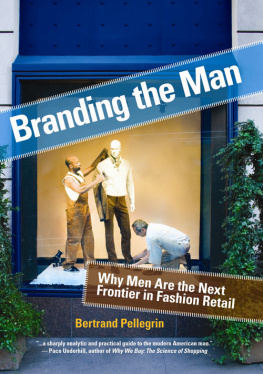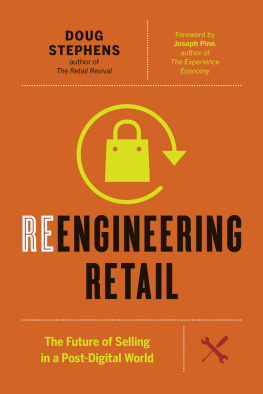2009 Bertrand Pellegrin
All rights reserved. Copyright under Berne Copyright Convention, Universal
Copyright Convention, and Pan-American Copyright Convention. No part
of this book may be reproduced, stored in a retrieval system, or transmitted in
any form, or by any means, electronic, mechanical, photocopying, recording, or
otherwise, without prior permission of the publisher.
12 11 10 09 5 4 3 2 1
The Talented Mr. Ripley by Patricia Highsmith is 1993 Diogenes
Verlag AG Zurich.
Published by Allworth Press
An imprint of Allworth Communications
10 East 23rd Street, New York, NY 10010
Jacket and interior designs by Tamara Gildengers Connolly
Page composition/typography by Integra Software Services, Pvt., Ltd.,
Pondicherry, India
ISBN: 978-1-58115-717-8
eBook ISBN: 978-1-58115-729-1
Library of Congress Cataloging-in-Publication Data:
Pellegrin, Bertrand.
Branding the man : why men are the next frontier in fashion retail / by Bertrand
Pellegrin.
p. cm.
Includes bibliographical references and index.
ISBN 978-1-58115-717-8 (alk. paper)
1.Male consumers. 2. Marketing. 3. Fashion. I. Title.
HC79.C6P45 2009
746.920688dc
2009014852
Printed in the United States of America
To my father
Evenings looking at his clotheshis clothes and Dickiesand feeling Dickies rings between his palms, and running his fingers over the antelope suitcase he had bought at Guccis. He had polished the suitcase with a special English leather dressing, not that it needed polishing because he took such good care of it, but for its protection. He loved possessions, not masses of them, but a select few that he did not part with. They gave a man self-respect. Not ostentation but quality, and the love that cherished the quality. Possessions reminded him that he existed, and made him enjoy his existence. It was simple as that. And wasnt that worth something? He existed.
from The Talented Mr. Ripley (1955) by Patricia Highsmith
Table of Contents
Profile | Marketing to the Masses:
How Mens Health Defines a Growing Demographic
Acknowledgments
T his book began as a masters thesis at the Academy of Art University. I knew then that this would become part of a larger project, but it took several years of shuttling between two continents before I was able to gain the additional insight I needed to understand the evolving American man.
Long ago, when I was a student at Lewis and Clark College, I became fascinated with the behavioral differences in gender and how a society reinforces those behaviors through a range of socialized messages and ritualized behavior. The politics of appearance not only affirm those messages but also enforce the gender uniformthe clothes we wear to convey our places amongst one another, as men or as women. Ones appearance can guarantee social acceptance and disguise social class; it ensures that the status quo, as it relates to gender behavior, is maintained. Appearance is but one way we express who we are, but it is also how we interpret who someone else is.
As a brand strategist and retail consultant, I use a variety of tools and extensive research to study the politics of appearance, whether in San Francisco or Seoul. But it is the people friends, colleagues, mentors, teachers, and familywho have been my most valuable allies and experts in helping make this book a provocative and useful tool for those who are interested in its subject.
So, it is with tremendous gratitude and appreciation that I acknowledge those from long ago and yesterday who gave me their patience and wisdom: at Lewis and Clark College, Professors Robert Goldman and Deborah Heath, and at the Academy of Art University, Joan Bergholt and retail consultants Jim Warshell and Gail Gordon (my earliest advisors in the development of the project thesis).
It was in Korea, China, and Hong Kong that I began much of my initial comparative research on how people shop and gained insight on the complex world of luxury retailing. I must thank Hyun Ouk Cho, CEO of LVMH Korea, Ltd.; Jean Yang, former retail manager of Louis Vuitton Korea, Ltd.; and Ms. Sunyoon Chang, former executive director of Lotte Shopping Groups Avenuel department store, in particular for her trust and and belief in my vision for a new approach to Korean luxury department stores.
Thanks must also go to my generous experts in the U.S. fashion industry: David Pilnick, senior vice president of international business ventures for Saks Fifth Avenue; designer John Varvatos; Mickey Drexler, CEO, and Todd Snyder, senior vice president of menswear at J.Crew: John MacDowell, owner of Oslos mens store in Seattle; Ken Lombardi, director of marketing, and Maz Hattori, buying manager, at Lombardi Sports in San Francisco; Marshal Cohen and Beth Boyle at NPD Research, Inc., who provided contextual analysis and research; and Andrew Hargadon, associate professor of technology management at the Graduate School of Management at University of California, Davis.
Special thanks must also be given to Dr. Kit Yarrow, consumer psychologist at Golden Gate University, for her compelling insight and research on the next generation of male consumers; and to my friend and mentor, Wilkes Bashford, president and CEO of Wilkes Bashford Stores, for sharing his wisdom in running one of the countrys best mens stores and for allowing me to use his store window and staff for the cover of the book.
To Yao-Lien Wang for his unfailing support and friendship. He not only designed the charts and graphs but also designed the initial manuscript when it was a humble masters thesis. He has never ceased to open my eyes to the world of design and art and has always encouraged me to express my ideas. Thank you also to Teru Yoshida, photographer of the image used on the book jacket as well as the portraits of men on the streets of U.S. cities.
To my publisher, Tad Crawford, and my editor, Janet Robbins, for their generous patience and sage advice in the revisions and additions to the final manuscript.
Last, I would like to thank my mother, Dr. Helen Pellegrin, who made exhaustive edits to this manuscript and was instrumental in shaping the delivery of what was said and how.
None of this book would be possible without these fine people, and I humbly offer my indebted thanks. It is with great honor and respect that I share my success with each of them.
Introduction
T his book is the result of several years of reflection, observation, and practice in the field of retail marketing and branding with special emphasis on the male customer. In the course of my experience, I have reached certain conclusions about the psychological, aesthetic, and practical aspects of turning men from passive acquirers into enthusiastic, loyaleven, dare I say, fashionablebuyers.
I propose to discuss how and why men shop and how a store can make itself irresistible to the masculine mind by appealing to perhaps unconscious desires. In addition, I will suggest methods that can be used to help store employees become valuable assets rather than grudging participants.
Branding the Man does not pretend to be the definitive manual about selling to men, nor are its recommendations to be taken as gospel. Rather, I see it as a study of a fast-developing population and the art of marketing to it. I hope it will be useful to neophytes(entrepreneurs and investors who are exploring the potential of the mens retail market); thought-provoking to seasoned merchandisers and retail managers; and ultimately entertaining and provocative to anyone who has ever wondered what on earth men see and feel when they enter a store.
In this book, I explore the remarkable and intriguing ways men have changed in the decades since the 1950s: the politics, social upheavals, and sociological underpinnings that have made the American man an even more attractive and susceptible market for everything from household products, to food, to fashion. Fashion is very much a pivotal marketing opportunity because fashion is inextricably part of the lifestyle of consumers self-expression, and in turn leads to other areas of consumption such as fine dining, travel, cars, and private aircrafts.
Next page








